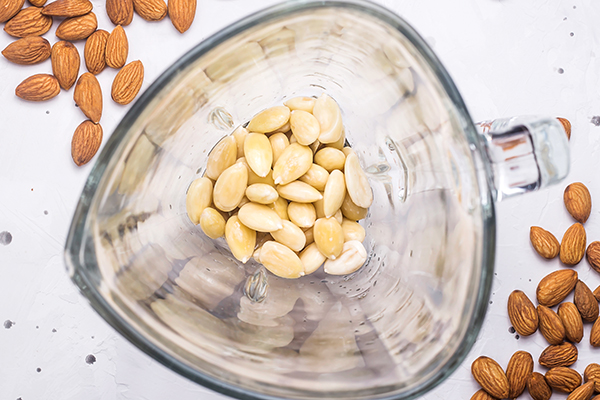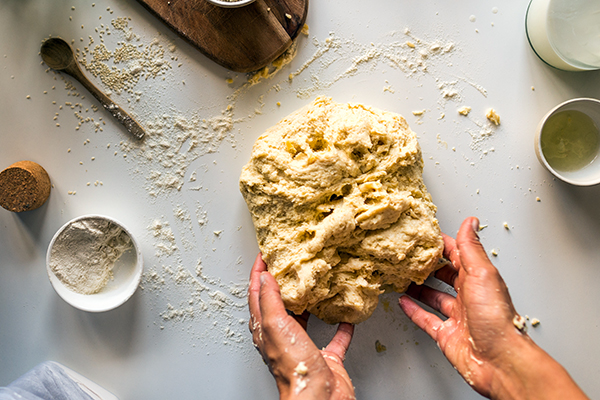Almond flour is not only very nutritious, but it’s also one of the most common grain-free and gluten-free flours.
Let’s go over the benefits of almond flour and how to cook with it.
What Is Almond Flour?
Almond flour is made from finely ground, blanched almonds after the skin is removed. How is this different from almond meal?
Almond meal is typically made from raw, unpeeled almonds and has a coarser texture. Almond flour has a finer texture and lighter color.
Both are gluten-free, Paleo-friendly, and add a rich and nutty flavor.
Almond Flour Nutrition
Almond flour is denser than all-purpose wheat flour, and this also applies to its nutrition profile.
It has more calories, fat, protein, and fiber compared to regular all-purpose flour.
According to Samantha Thoms, M.P.H., R.D., “If you’re looking to avoid gluten or substitute flour for a lower carbohydrate option, it can be a good choice.”
Gram for gram, almond flour has more calories than wheat flour.
And if you’re watching your fat intake, almond flour has significantly more fat than traditional flours.
That doesn’t make it an unhealthy flour choice, though. Despite the higher calorie count, almond flour contains many beneficial nutrients.
What Are the Benefits of Almond Flour?
Why is almond flour healthy?
Thoms explains, “Since almond flour is made from blanched and ground almonds, its nutritional content is similar to that of whole almonds.”
The same goes for the benefits.
1. Almond flour is nutritious
Because it’s made from almonds, this nutritious flour also contains valuable vitamins, minerals, and magnesium.
Magnesium is vital for maintaining a healthy metabolism and plays a key role in bone, cell, and chromosomal structures.
2. Almond flour may help with fullness
Both fiber and protein are known to increase satiety and keep you feeling fuller for longer.
Almond flour boasts much higher fiber and protein compared to regular wheat flour. This may be helpful for whipping up foods that taste good as well as feel more satisfying.
3. Almond flour may help with heart health
Almond flour contains heart-healthy unsaturated fats that may help promote better cholesterol levels.
Specifically, the good fats in almonds may lower LDL (“bad”) cholesterol while raising HDL (“good”) cholesterol.
4. Almond flour is gluten-free
Gluten is a protein present in grains like wheat, barley, and rye. If you have celiac disease or gluten sensitivity, you’ll have an immune reaction to gluten, which can cause inflammation and other digestive issues.
Improving these symptoms means following a gluten-free diet and giving up bread and other baked goods. Gluten-free baking with almond flour can allow you to still enjoy the foods you love.
How to Make Almond Flour at Home
If you purchase whole almonds in bulk, you can make a range of almond-based ingredients, including almond flour, almond meal, almond butter, and almond milk.
To make almond flour, you’ll need blanched almonds and a food processor or high-powered blender (think: Vitamix or Blendtec).
Blanched almonds are almonds without the skin. To remove the skin, simply soak your almonds in cold water overnight.
Then drain and squeeze the almonds till they pop out of the skin. Let your almonds dry overnight as a single layer on a baking tray.
Finally, pop your dried blanched almonds into a food processor or blender.
Be careful about blending too long, or else you’ll end up with almond butter!
- Food processor: Use the pulse setting, 1 to 2 seconds at a time, until you get a fine powder. This can take a few minutes.
- High-powered blender: Blend at the highest setting for 10 to 15 seconds until you get a fine powder.
Tips for Cooking with Almond Flour
You can use almond flour in place of wheat flour in sweet baked goods — pie crusts, cookies, cakes, and breads.
Its coarser cousin, almond meal, can also be used in baked goods but won’t result in the same fine texture.
You can use both almond flour and almond meal as bread crumbs in savory dishes like meatballs, meatloaf, or as a coating on baked fish or chicken.
Sadly, you can’t use almond flour to thicken liquids like soups, but if you want a grain-free flour that can do that, try banana flour.
Almond flour contains more moisture than all-purpose flour, so you can’t replace it in recipes as a 1:1 ratio.
It’s usually blended with other flours due to its high calorie and fat content, and your baked goods may be denser than if you made them with another flour.
If you don’t like this, try reducing the amount of almond flour you mix your flour of choice.
It might take some experimenting before you find almond flour recipes that you like.
But you can find many almond flour recipes on the Internet, such as:
- Pancakes
- Waffles
- Cookies
- Cakes
- Breads
- Cobblers and crisps
- Muffins
- Pie crusts




























